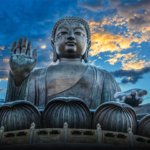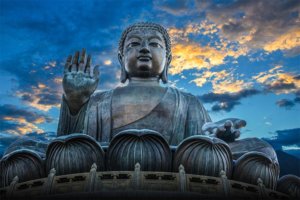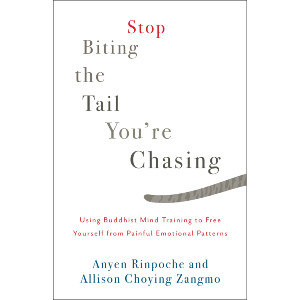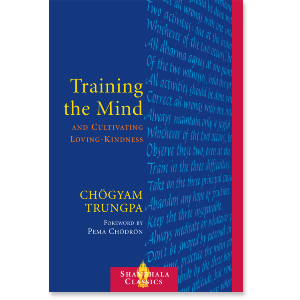The renowned Buddhist master Jowo Je Atisha (982–1054) was a sage from India known for bringing the extremely pure Kadampa lineage of Buddhism from India to Tibet nearly one thousand years ago. One thing that made Atisha such a unique and renowned master is that he took the teachings on bodhichitta (Skt. awakened mind) as his main and constant practice. As we learn from the example of Atisha’s life and practice, bodhichitta practice can help us become extremely skillful at working with our emotions. Though bodhichitta literally means “awakened mind,” it carries with it the further implication of the aspiration to place all sentient beings in the state of enlightenment, which indirectly enables us to realize the nature of wisdom ourselves.
A simpler way that we can understand bodhichitta is that its very essence is to put the well-being and happiness of others before our own, as we discussed in the previous chapter. Many of us may think we already do this. If we think in this manner, we probably need to dig deeper. Even though Western culture has a long tradition of practicing compassion, it can still be difficult to get a sense of what it means to train in bodhichitta, which goes far beyond ordinary compassion. We can distinguish the practice of bodhichitta from more ordinary empathy and compassion because with bodhichitta, we are trying to unearth the deepest layers of self-centeredness that lie buried within us in connection to our positive action. The wish to get something for ourselves can have many faces. It is also intrinsically related to our emotional state of mind and self-attachment. When we help others, we may have more overt wishes for those people to return the favors in kind. But we also probably have other, more hidden selfish motivations, such as avoiding uncomfortable situations, being self-protective, or making ourselves feel more secure, using our positive actions to feel good about ourselves or making others like us or think about us in certain ways. We should also remember that the benefit to ourselves, the realization of wisdom that results from the perfection of bodhichitta, is an indirect result. If we were to act kindly and selflessly toward others while having the wish to attain some kind of spiritual goal, we would not be practicing genuine bodhichitta.
Even though Western culture has a long tradition of practicing compassion, it can still be difficult to get a sense of what it means to train in bodhichitta, which goes far beyond ordinary compassion.
We may not think of seemingly positive actions as being the manipulators of our life situations, but when we entertain selfish thoughts and feelings, we are always, directly or indirectly, trying to be the architects of the scenarios we are facing. When we start to train seriously in bodhichitta, we begin to reverse our ordinary selfish tendencies—the same unhappy tendencies that cause us to keep the focus on ourselves and our own emotions. So it follows that to start training in bodhichitta, we must be willing to turn our ordinary ways of thinking, feeling, and doing upside down.
Bodhichitta is not a practice easily mastered because the emotional habits that we have developed run so deep. They are not like the ordinary paths worn into a hillside by frequent walking but rather more like deep ravines cut by swift flowing water. In fact, it is said that of all the teachings in Tibetan Buddhism, the teachings on bodhichitta are the most difficult to master because this practice fundamentally transforms the ordinary approach we take toward every aspect of our lives.
The difficulty of practicing bodhichitta in the modern world was in fact prophesied by the Tibetan masters of old. Traditionally the teachings on bodhichitta were always the first teachings to be received, practiced, and mastered, but that isn’t so in the modern world. It was said that in this modern age, the teachings of bodhichitta would become a secret aspect of the dharma, becoming more and more hidden as the years passed. This prophecy refers to the fact that in this modern age, people have extremely strong emotions and strong self-attachment. Fewer and fewer people see the value in releasing the grip they have on their emotions—or rather, that their emotions have on them—or dedicating themselves to spiritual practice. When we have the chance to read about and reflect on bodhichitta, or to begin to put it into practice, we should feel extremely fortunate that we have made a connection with such a genuine approach to spiritual growth and development that is said to be so rare and hard to find in this modern age.
The Approach of Ordinary Beings
In the famous text The Thirty-Seven Practices of a Bodhisattva, the Buddhist master Gyalsé Togmé Zangpo (1297–1371) describes the ordinary approach of ordinary beings as treating our friends and loved ones with attachment and love, and treating those we dislike or feel disconnected to with anger, hatred, or distaste. But because bodhichitta is a state of heart and mind that enables us, ultimately, to love others equally and impartially, we are called upon to change this habit we have of relating to our emotions, as well as to our connections, as friends and enemies. When we practice bodhichitta, we must be willing to appreciate, love, and care for all sentient beings despite our perceptions, the history or lack of history between us, or our current relationships with them. What is even more difficult is that we must be willing to put aside our own needs, comfort, and wishes in order to make space in our hearts and minds for others and their needs.
Atisha and the Lojong Teachings
Like Patrul Rinpoche and other sages, Atisha had a radical approach to living. When we view his life through the lens of bodhichitta, we see that he exemplifies the way to heal ourselves physically, mentally, and emotionally so that we are healthy enough to serve others. It is said that when Atisha traveled to Tibet to teach the dharma, he brought with him a monkey who constantly soiled his body and his clothing, and an irate cook who often shouted at him. Because Atisha was a great Indian Buddhist master, he was highly revered and respected by all Tibetan people. He could have had the most comfortable home and the best clothing, and he could have been treated like a king by everyone around him. But Atisha, being wise, knew this would not ultimately bring him happiness or enable him to serve others. When asked by his students why he didn’t just get rid of the annoyances of the monkey and the cook, Atisha said, “All of you Tibetans are so nice to me. How will I ever learn to practice patience if I don’t live with the monkey and the cook? You see the monkey and the cook as enemies. Actually, they show me more kindness than my students do by giving me the opportunity to practice.”
The greatest kindnesses are given to us by those things—or people—that we want to get rid of, those things that make us uncomfortable, angry, irritated, and impatient.
In this story, Atisha gives us even more insight into the nature of friends and enemies. According to Atisha and the general Mahayana Buddhist teachings, the greatest kindnesses are given to us by those things—or people—that we want to get rid of, those things that make us uncomfortable, angry, irritated, and impatient. And the kindnesses shown by those who love and treat us well are more like the actions of enemies, since these kindnesses reinforce our sense of self-cherishing, which only brings us greater and greater unhappiness.
This story about the life and habits of Atisha is a beautiful introduction to the canon of teachings referred to as lojong, literally “mind training,” practiced by all followers of the bodhisattva path. In the West, lojong has come to be associated with a set of slogans and sayings that help us kindle mindfulness in many different situations. But in the context of the Buddhist tradition, lojong is a vast topic. We could think of it as the whole of engaged spiritual practice, using all the situations we face—positive, negative, and neutral—for self-improvement and spiritual development. So lojong cannot be limited to one practice or set of teachings. Actually, all of the eighty-four thousand different teachings taught by the historical Buddha Shakyamuni can be called lojong; their goal is to help us decrease and ultimately destroy self-attachment.
No matter what our problems and difficulties, the root of our unhappiness is exactly the same: we cannot get what we want, and unwanted things keep happening.
Because he was a great lojong master, Atisha can be considered an authoritative source of advice about how to develop emotional balance and stability. After all, Atisha was willing to approach life in a way that tore down all the walls and boundaries in his mind, so that he could get beyond his ordinary habits and simply work for the happiness and welfare of others. We may think that someone living a thousand years ago couldn’t comprehend the kinds of difficulties we face in the modern world today. But no matter what our problems and difficulties, the root of our unhappiness is exactly the same: we cannot get what we want, and unwanted things keep happening. We have taken birth and now are facing the aging, sickness, and death of ourselves and our loved ones.
Share
Stop Biting the Tail You’re Chasing
$16.95 - Paperback
Training the Mind and Cultivating Loving-Kindness
$16.95 - Paperback
$19.95 - Paperback
$21.95 - Paperback
Pema Chödrön's Compassion Cards
$16.95 - MixedMedia
$19.95 - Paperback
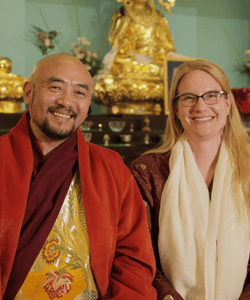
Allison Choying Zangmo is Anyen Rinpoche's personal translator and a longtime student of both Rinpoche and his root lama, Kyabje Tsara Dharmakirti.

